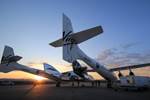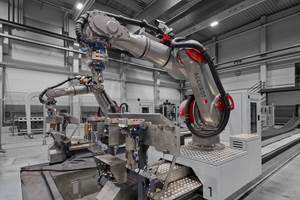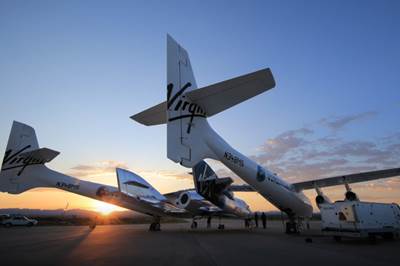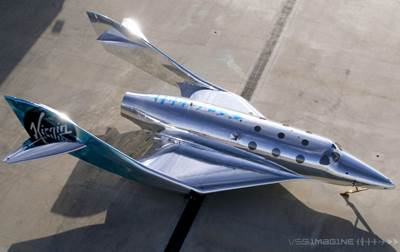Virgin Galactic SpaceShipTwo completes third crewed spaceflight
All-composite VSS Unity reached suborbital space at a speed of Mach 3, marking the first human spaceflight from its New Mexico home port, and another step toward commercial operations.
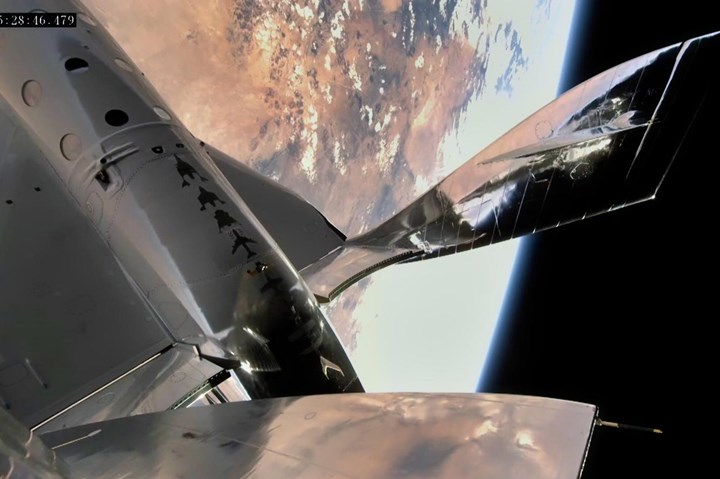
VSS Unity hovering over New Mexico in space. Photo Credit: Virgin Galactic
On May 22 Virgin Galactic (Mojave, Calif., U.S.) completed its third spaceflight (the second occured back in February 2019) and the all-composite VSS Unity’s first spaceflight from Spaceport America (Las Cruces, N.M., U.S.). This flight, reports the company, sees New Mexico become the third U.S. state to launch humans into space.
The SpaceShipTwo vehicle achieved a speed of Mach 3 after being released from the mothership, VMS Eve, and reached space, at an altitude of 55.45 miles before gliding smoothly to a runway landing at Spaceport America.
On VSS Unity’s flight deck were CJ Sturckow and Dave Mackay, while Kelly Latimer and Michael Masucci piloted VMS Eve. CJ, who flew as pilot-in-command, is said to have become the first person to have flown to space from three different states. Virgin Galactic notes that the crew experienced extraordinary views of the bright, blue-rimmed curvature of the earth against the blackness of space. New Mexico’s White Sands National Park sparkled brilliantly below. Their experience gives Virgin Galactic’s Future Astronaut customers a glimpse of what lies ahead.
“This flight showcased the inherent elegance and safety of our spaceflight system, while marking a major step forward for both Virgin Galactic and human spaceflight in New Mexico,” says Michael Colglazier, CEO of Virgin Galactic. “Space travel is a bold and adventurous endeavor, and I am proud of our talented team for making the dream of private space travel a reality. We will immediately begin processing the data gained from this successful test flight, and we look forward to sharing news on our next planned milestone.”
Virgin Galactic fulfilled a number of test objectives during the flight, including:
- Carried revenue-generating scientific research experiments as part of NASA’s Flight Opportunities Program.
- Collected data to be used for the final two verification reports that are required as part of the current Federal Aviation Administration (FAA) commercial reusable spacecraft operator’s license.
- Tested the spaceship’s upgraded horizontal stabilizers and flight controls and validated EMI reductions.
Following the flight, and in line with normal procedures, Virgin Galactic says it will conduct a review of all test data gathered and thoroughly inspect the spaceship and mothership. Once the team confirms the results, the company plans to proceed to the next flight test milestone.
To celebrate the first human spaceflight from New Mexico, the Zia Sun Symbol of New Mexico’s state flag was placed prominently on the exterior of the Spaceship. In addition, the company flew green chile seeds, synonymous with the state’s rich agricultural and culinary history.
“Fifteen years ago, New Mexico embarked on a journey to create the world’s first commercial spaceport,’’ says Sir Richard Branson. “Today [May 22], we launched the first human spaceflight from that very same place, marking an important milestone for both Virgin Galactic and New Mexico. I am proud of the team for their hard work and grateful to the people of New Mexico who have been unwavering in their commitment for commercial spaceflight from day one. Their belief and support have made this historic achievement possible.”
This spaceflight was conducted under strict COVID-19 protocols.
Related Content
Low-cost, efficient CFRP anisogrid lattice structures
CIRA uses patented parallel winding, dry fiber, silicone tooling and resin infusion to cut labor for lightweight, heavily loaded space applications.
Read MoreIndustrializing additive manufacturing in the defense/aerospace sector
GA-ASI demonstrates a path forward for the use of additive technologies for composite tooling, flight-qualified parts.
Read MorePlant tour: Aernnova Composites, Toledo and Illescas, Spain
RTM and ATL/AFP high-rate production sites feature this composites and engineering leader’s continued push for excellence and innovation for future airframes.
Read MoreAutomated robotic NDT enhances capabilities for composites
Kineco Kaman Composites India uses a bespoke Fill Accubot ultrasonic testing system to boost inspection efficiency and productivity.
Read MoreRead Next
SpaceShip Two prepares for first spaceflight
Virgin Galactic prepares its vehicles, pilots, team and facilities with rigorous pre-flight checks and objectives before the flight which will be carried out later this fall.
Read MoreVirgin Galactic SpaceShip III unveiling to deliver commercial space travel
Manufacturing ramp-up and ground testing for VSS Imagine spaceship within the Virgin Galactic fleet, with glide flights commenced for summer 2021.
Read MoreScaling up, optimizing the flax fiber composite camper
Greenlander’s Sherpa RV cab, which is largely constructed from flax fiber/bio-epoxy sandwich panels, nears commercial production readiness and next-generation scale-up.
Read More

